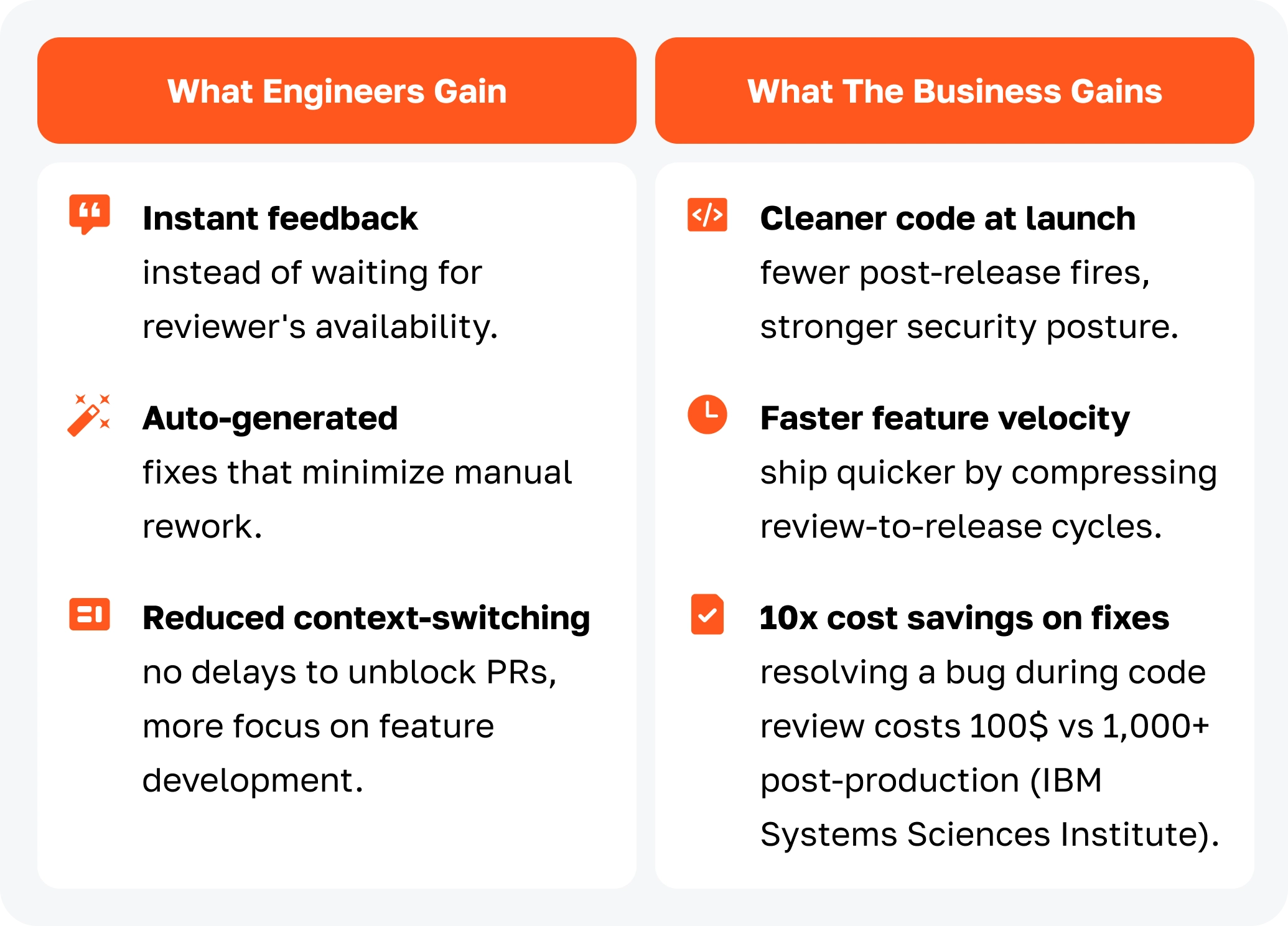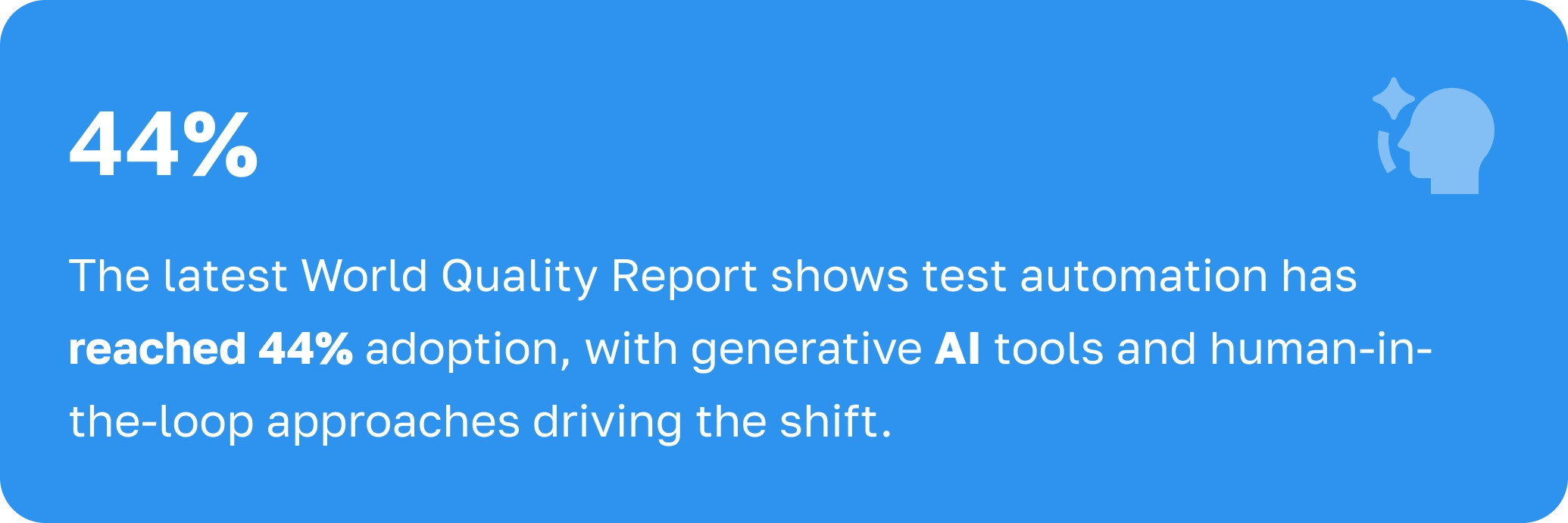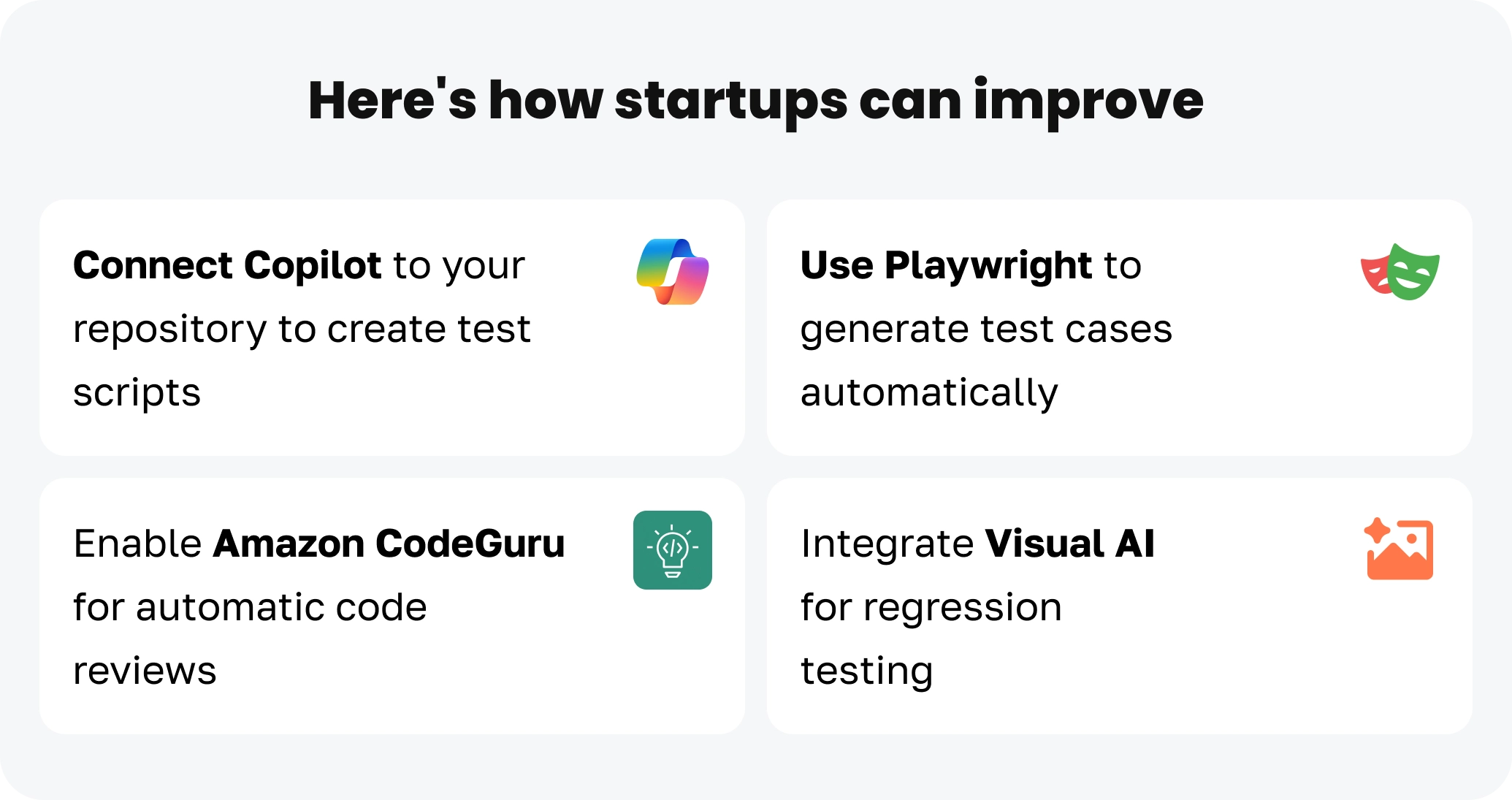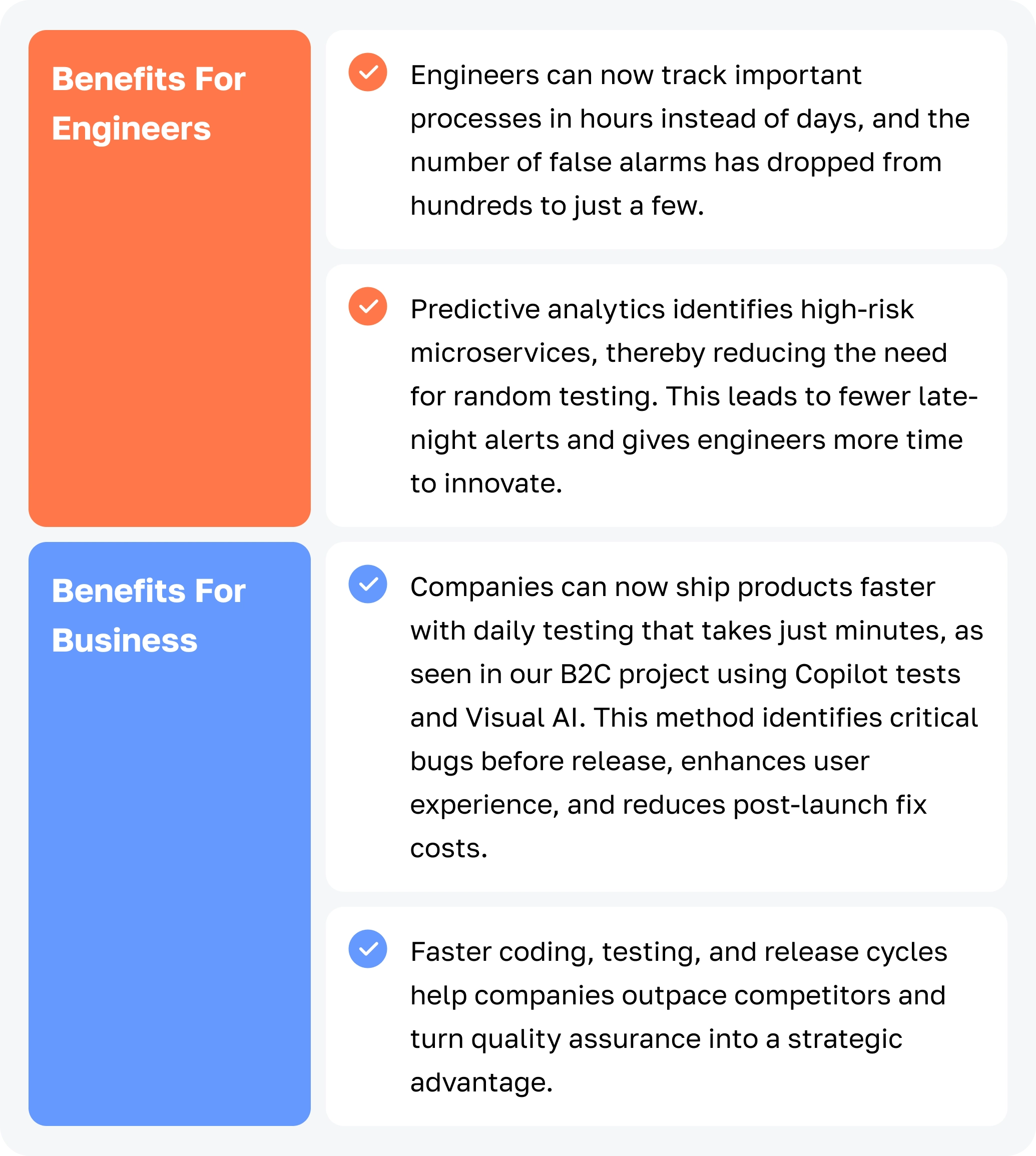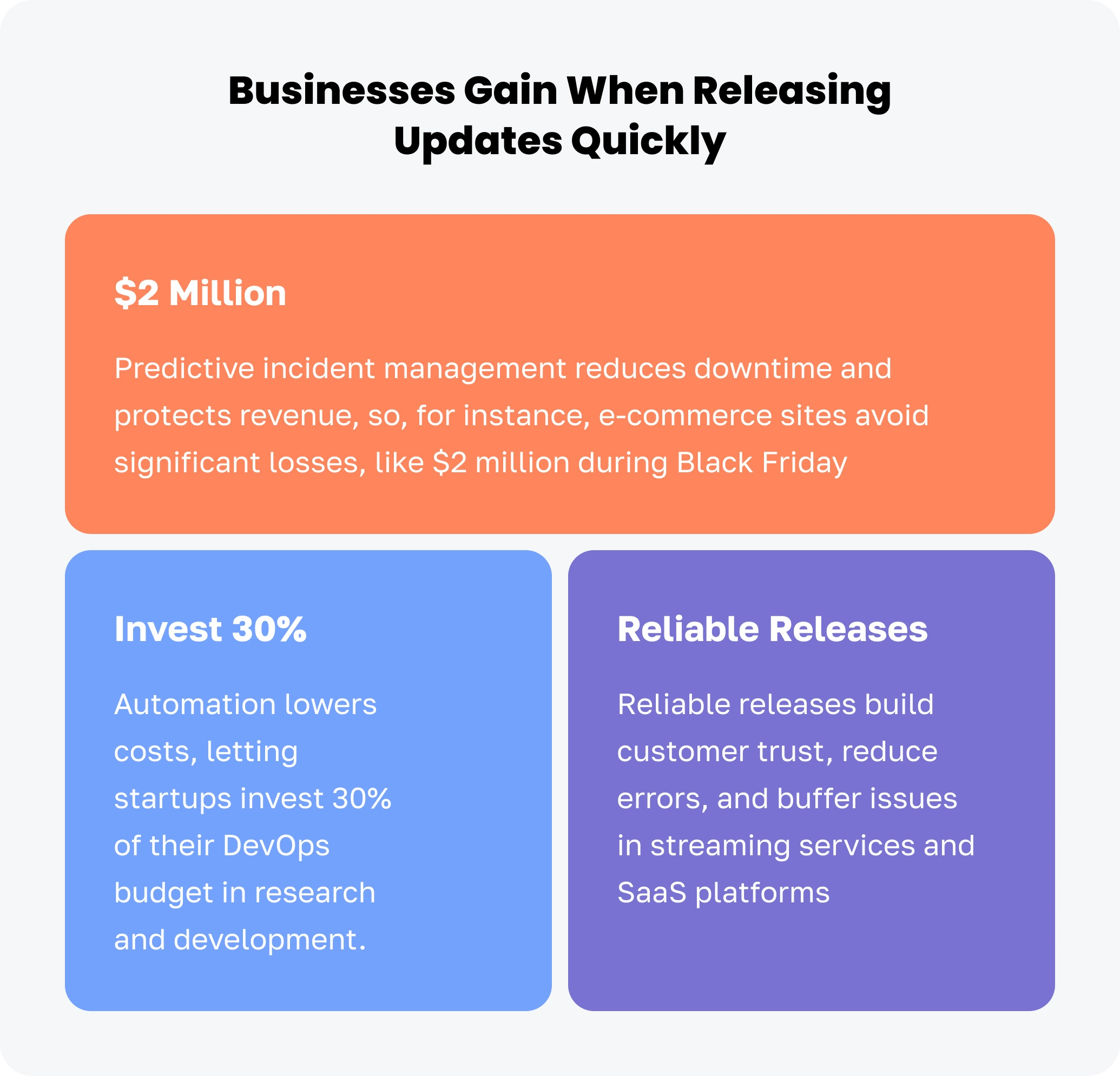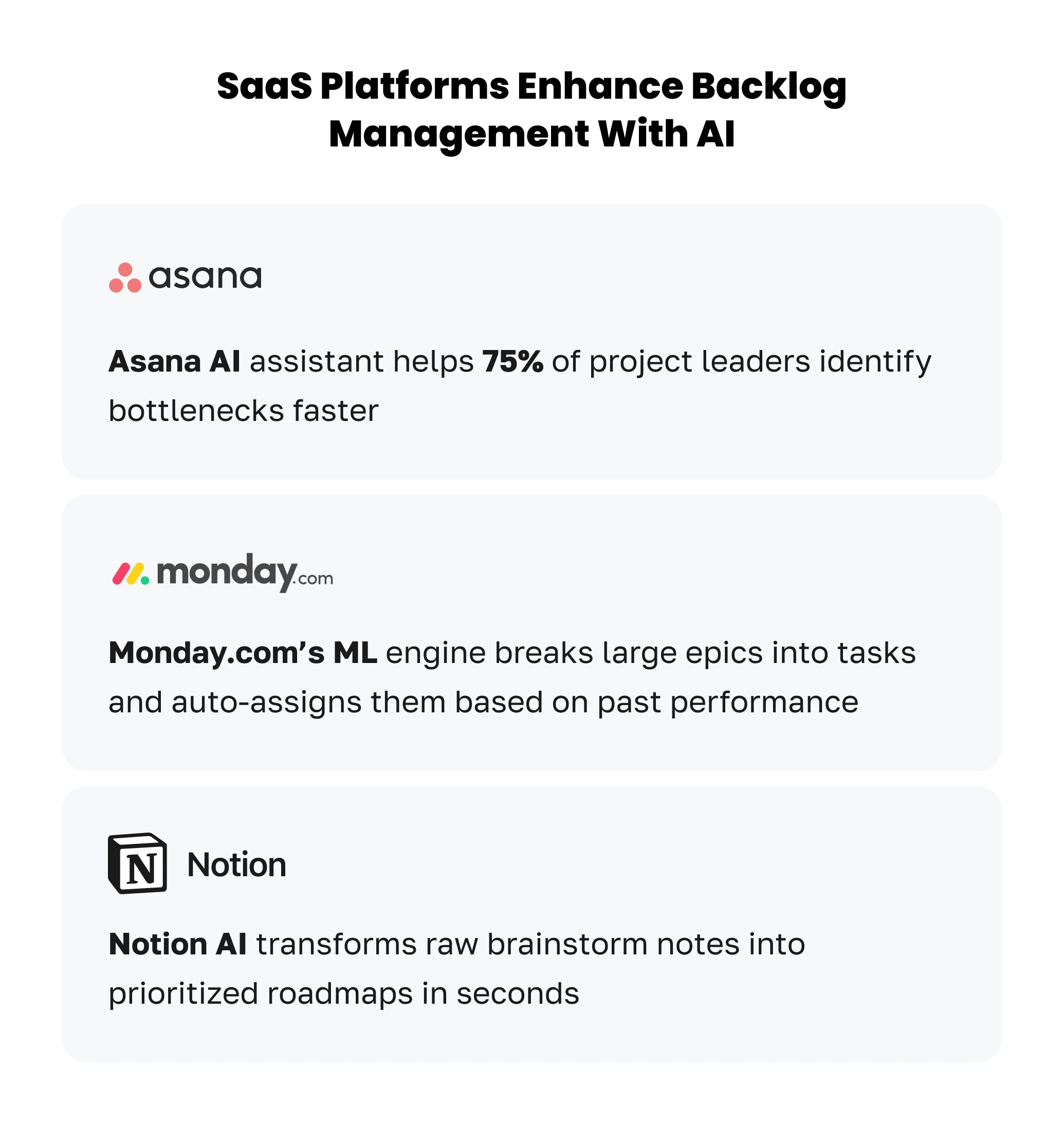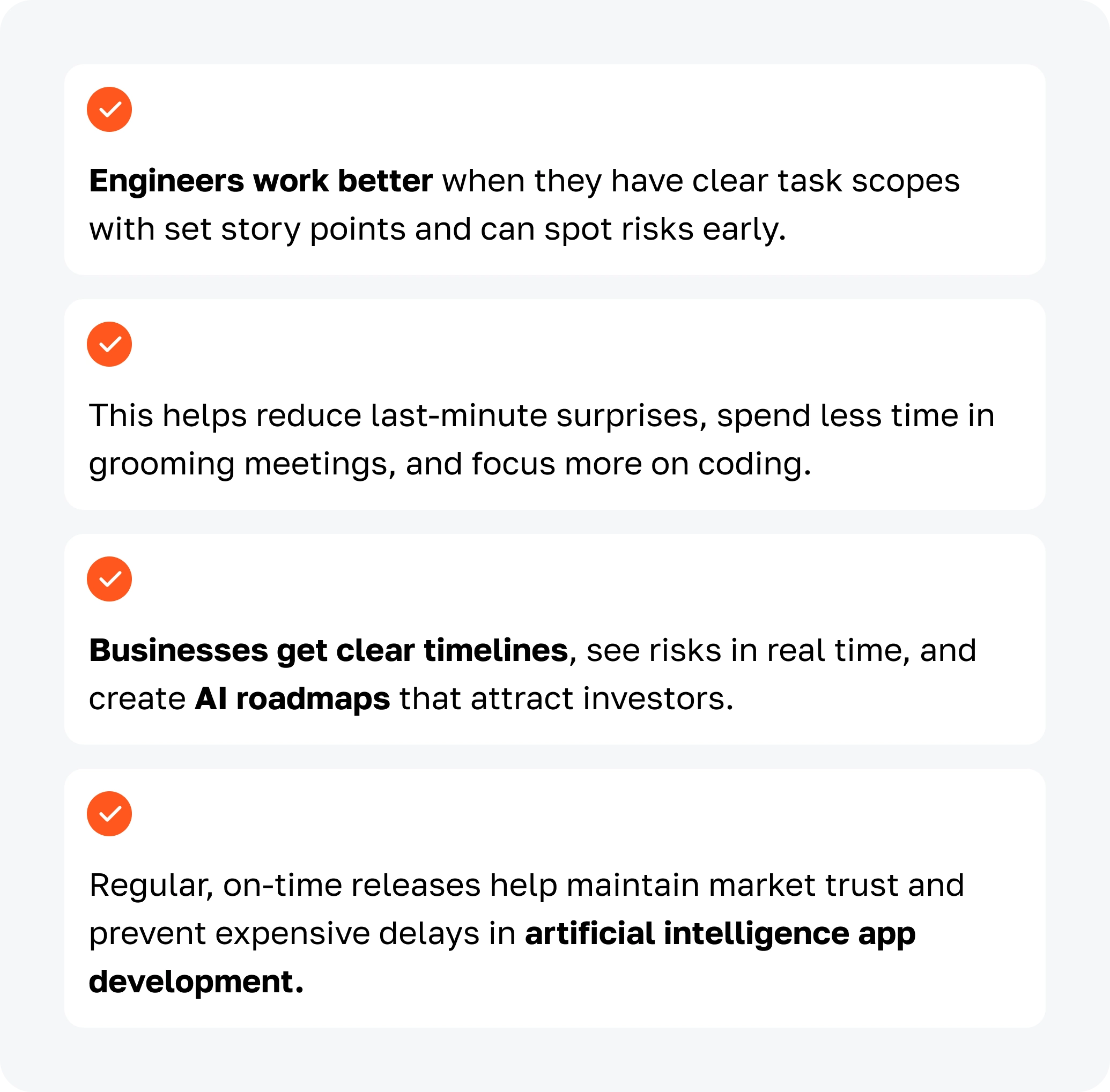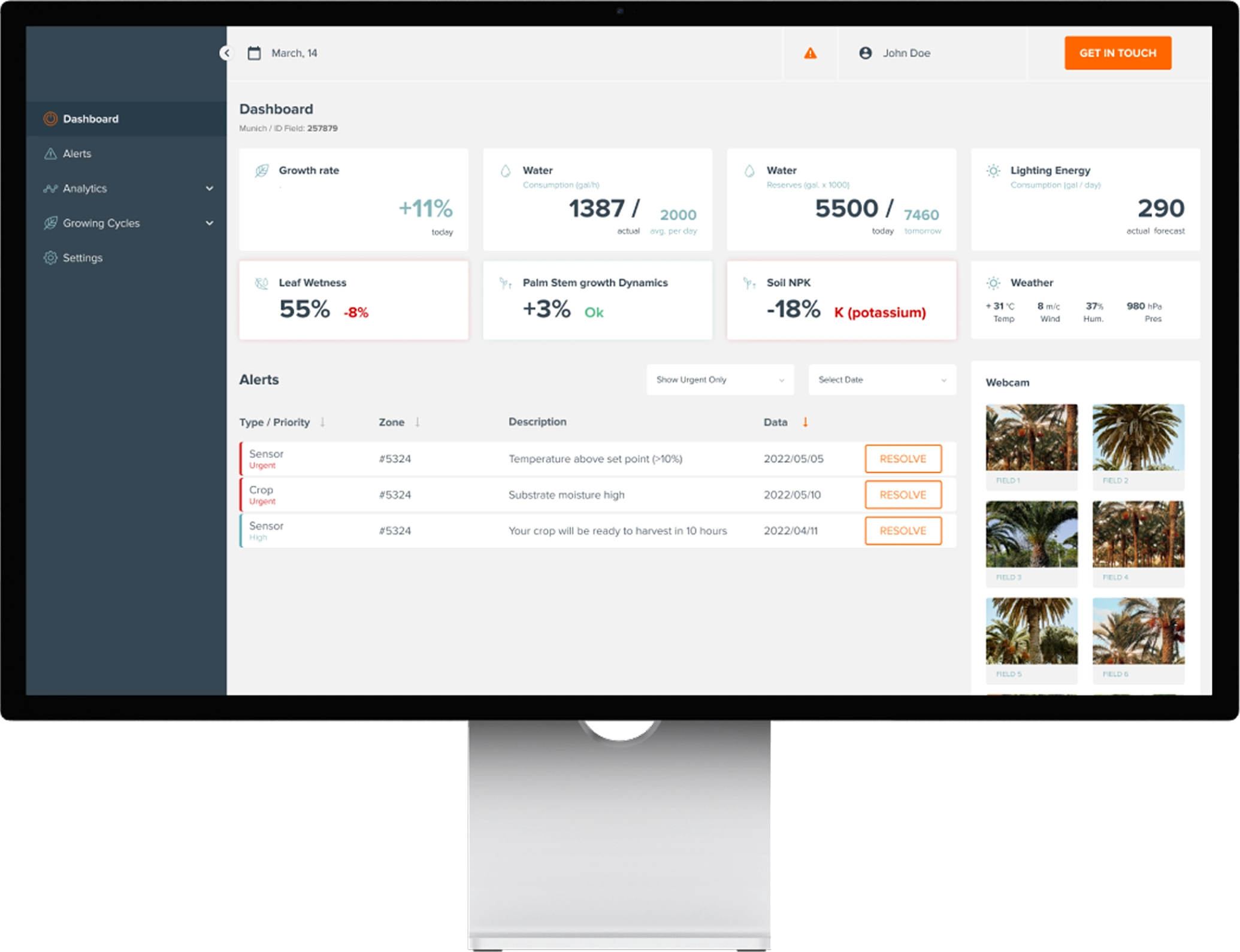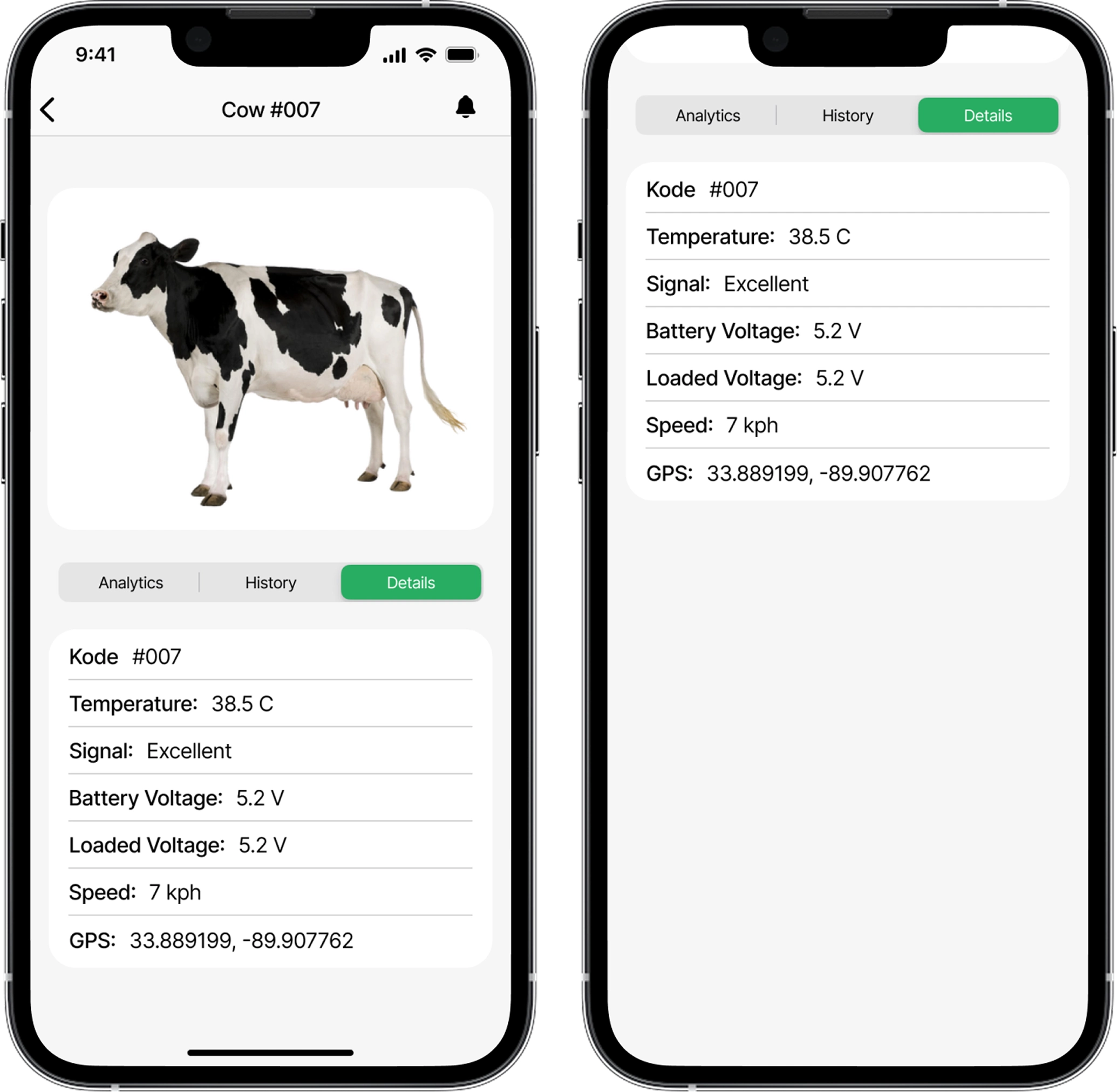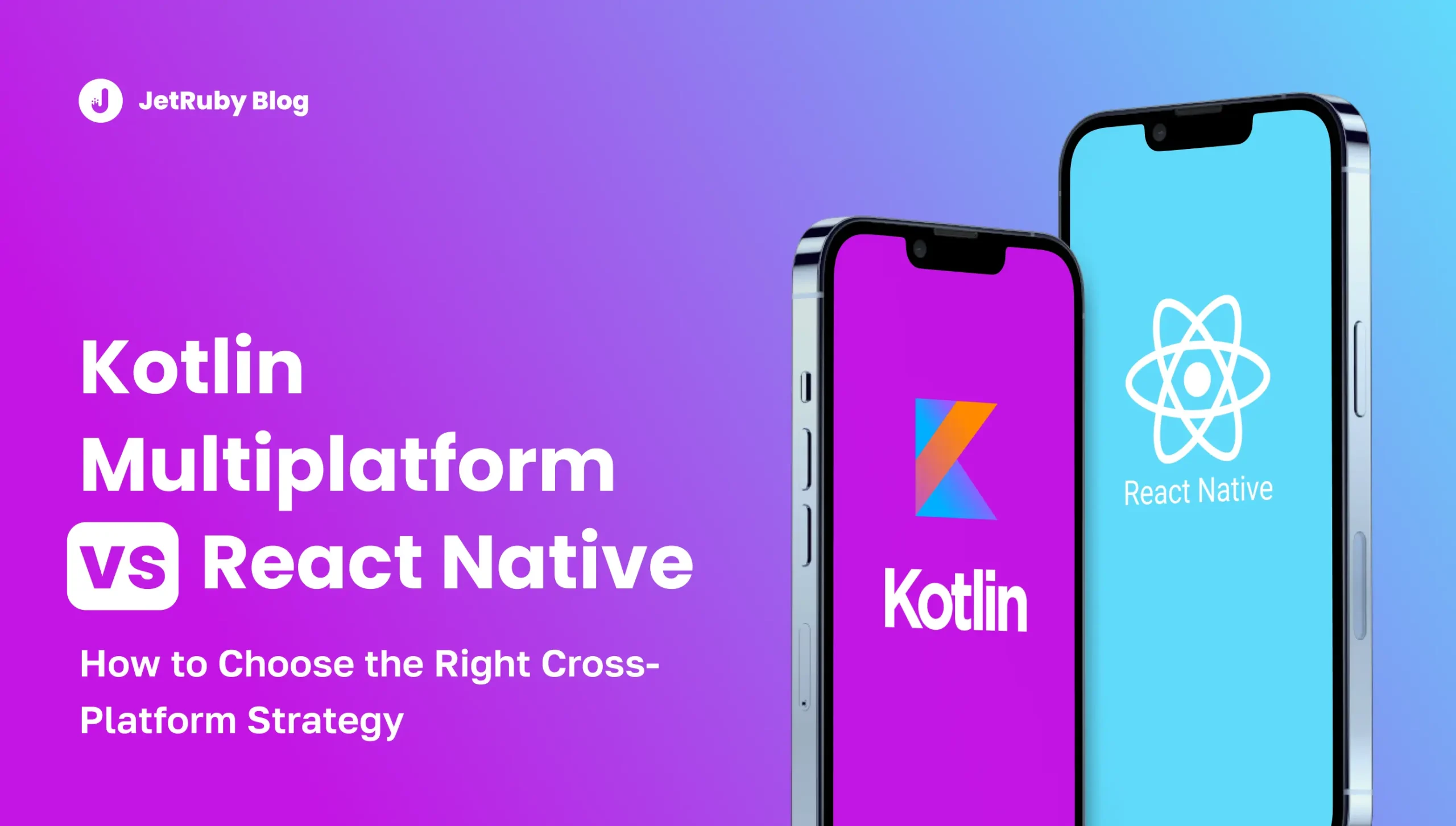Table of Contents
At the start of 2024, 71% of organizations had already folded generative AI into at least one business process.
Teams that use tools like GitHub Copilot report they write new functions 55% faster and catch bugs earlier in the cycle.
Meanwhile, they project that the overall AI market will surge from roughly $372 billion in 2025 to $2.4 trillion by 2032. It means artificial intelligence app development will soon be the #1 priority for app development companies.
Startups without AI assistance face months of repetitive coding, long QA cycles, and costly scaling.
Here we’ll provide a clear AI roadmap with market insights, tech details, and examples to help your development team build an AI-powered app faster.
Key Takeaways
- Strong AI frameworks and large funding create a great opportunity to build an AI app
- Automated review AI agent catches about 80% of security and style flaws before merge, reducing bug-fix costs.
- Generative AI writes end-to-end tests in minutes, cuts over 90% of false positives, and shrinks regression runs from days to hours.
- On-device inference and behavioral models boost retention and lifetime value by up to 25%.
- AI-driven CI/CD and AIOps pipelines cut downtime by 40% and MTTR under one hour.
- AI-assisted backlog grooming and sprint forecasting reduce schedule slips by 30%.
Why 2025 Is the Best Moment for AI App Development
Consultancies call AI the foundation beneath nearly every technology trend for the next 18 months.
PwC estimates that AI’s cumulative boost to global GDP will reach $15.7 trillion by 2030.
That torrent of capital means investors now hunt for teams skilled in AI app development to turn proofs-of-concept into comprehensive web and mobile app development services, especially as alternative app stores gain traction.
Tools like GitHub Copilot and Amazon CodeWhisperer help developers write unit tests and review code faster within the IDE, reducing routine coding time by half.
This speed reduces MVP cycles from several months to just a few weeks, and makes AI for app development a significant advantage. Subscription-based pricing makes advanced AI available in mobile app development.
A small AI-powered team can now do the work of two traditional teams, giving startups a competitive boost in terms of speed and cost.
With a clear opportunity in the market, let’s see how AI influences code creation for frontend and backend development.
AI-Powered Frontend and Backend: Write Code Faster than Ever
Numerous studies have shown that developers are happier and can be up to 45% more productive when using AI coding assistants, particularly in mobile app development, highlighting key benefits of AI.
In 2024, businesses quickly adopted AI technology. Many AI-focused companies started investing in AI for app development to reduce costs and accelerate processes, recognizing how AI is transforming workflows.
“By automating routine tasks and improving efficiency, AI will have a major impact on the economy, changing industries, creating new markets, and shifting competition,” said Lapo Fioretti, senior research analyst at IDC.
Developers leverage powerful AI capabilities to write client and server code quickly, so they focus on business logic and user experience.
On the frontend, popular AI tools like Copilot and Codeium help developers write entire app components like React hooks easily.
When a developer types a simple function name, such as useFetch(url), these tools automatically include error handling, documentation comments, and Jest tests.
This process leans on file context and project conventions, then returns production-ready code in under a second.
Shifting to the backend, Amazon CodeWhisperer reads comments such as // create user in DynamoDB and generates a Lambda handler, schema definitions, error-trap logic, and logging statements.
What once took a developer half a day now completes in about twenty minutes, helping teams build smarter and prototype API endpoints at lightning speed.
Database teams can benefit from Prisma’s AI-Advisor. It identifies missing indexes and suggests ways to improve queries before launch — a must for artificial intelligence application development and optimizing app performance.
In a FinTech project, our team resolved 63 major security issues in a single day using Snyk DeepCode’s autofix. This task would have taken three days if done manually without AI assistance, demonstrating a successful AI implementation.
Across full-stack workflows, these AI assistants lift sprint velocity by 30–40%. Two engineers using code hints now match the output of three without them.
As companies explore how to create an artificial intelligence app, integrating these tools becomes non-negotiable, especially for those getting started with AI.
After sped-up code creation, the next priority is ensuring the code stays clean and secure through AI-driven review.
When teams combine AI and mobile apps, they code faster and ship cleaner. Safer builds are a crucial move in any artificial intelligence roadmap.
Follow a clear roadmap to learn AI and scale your projects — start with data collection, move to model training, then refine in production.
Code Review on Autopilot — Ship Cleaner Commits, Faster
A global DevOps.com survey found that 38% of respondents spend up to 25% of their time fixing software bugs, and 26% spend up to 50% of their time.
Snyk’s DeepCode feature scans PRs against over 150 security patterns and generates patch suggestions with about 80% precision — ideal for building your first AI project.
The AI-augmented software development market is growing quickly and will keep growing through 2027, according to IDC.
What’s the key driver?
AI-powered code review tools are transforming the way developers identify and resolve issues in their code.
More than 4 million developers worldwide use Snyk DeepCode AI.
Amazon CodeGuru prioritizes findings by real-world runtime risk and surfaces urgent defects first.
Google’s AutoCommenter service automatically inserts best-practice notes on style and architecture, sparing senior reviewers from routine comments.
This automation slashes review cycles and catches defects before they reach QA or production.
IDC predicts that by 2026, 75% of enterprise code will either be machine-generated or machine-verified. This trend aligns with the roadmap for AI engineers who plan to master AI in technical workflows.
For startups without dedicated QA or experienced engineers, AI chatbots and tools like Snyk, DeepCode, and GitHub Copilot Chat can be very helpful.
Small teams can automate code reviews and fix vulnerabilities adding these tools to their CI/CD pipelines from the start, a smart approach to AI app development.
AI helps startups automate tasks like static analysis, security checks, and style corrections in real time, thereby preventing technical debt from building up, so there’s less to fix after launch.
Once you secure clean code, you can automate testing at scale to catch regressions faster than ever.
For teams eager to learn AI and integrate artificial intelligence in mobile app development, the future of clean, secure code starts now.
Dive deeper into AI-powered code review for Rails. Learn how AI code review enhances Ruby on Rails projects and accelerates secure, maintainable code.
QA Automation: Bug Hunting at Machine Speed
AI is changing software testing just as much as Copilot changed coding. Manual bug hunting is less useful.
AI helps reduce mistakes and false alerts by using past data and self-adjusting tests that adapt to changes in code. You can train your AI systems to perfectly match your unique goals.
Just as developers leverage AI for application development to improve coding, testers now leverage AI to monitor smart systems.
Engineers describe a user journey, like “log in, add item to cart, checkout.” GitHub Copilot then creates a Playwright script, including navigation steps and error handlers, in under ten minutes, rather than several hours.
Microsoft’s official tutorials confirm that AI-assisted test authoring cuts creation time by over 80%.
There is no doubt that modern code reviews are essential. But they are also tedious.
Amazon CodeGuru Reviewer simplifies this by integrating directly into GitHub pull requests. Using AI trained on billions of code lines, it detects critical issues like concurrency bugs, resource leaks, and security anti-patterns before code merges.
It stabilizes unstable code, preventing post-deployment bugs. For example, fixing a resource leak in a PR can save days on memory issues later.
Developers receive actionable feedback in their workflow, learning AWS best practices while maintaining pace. CodeGuru highlights high-risk flaws and improves its suggestions over time.
Applitools Visual AI verifies UI snapshots against a baseline, ignoring dynamic regions and reducing false positives from hundreds to just a few genuine issues, allowing QA teams to focus on critical bugs.
Predictive analytics identifies fragile microservices through past build failures and bug trends, so teams target test coverage where risks are highest.
Forrester predicted that 2025 will be when leaders digest the lessons of 2024 and begin monetizing Gen AI, including AI-powered QA platforms.
If you are still writing tests manually, you are wasting your budget on outdated methods.
This approach will reduce production bug reports and speed up release cycles within just one quarter.
With quality assured, let’s turn to personalizing user experiences on mobile platforms.
AI in Mobile App Development: Personalizing the User Experience
What is an AI app?
It’s one that transforms interfaces into dynamic systems by analyzing user behavior in real time.
It learns individual preferences, habits, and contexts to deliver personalized content, features, or recommendations right when users need them — a hallmark of what an AI app must achieve.
For example, generative AI can tailor product suggestions, optimize workflows, or predict user needs before explicitly stating them.
Leaders in AI mobile app development services view personalization as the main way to increase revenue.
Twilio Segment finds 86% of decision-makers expect apps to use predictive suggestions soon, while PwC notes over 80% of consumers share data for personalized services.
TensorFlow Lite AI builds taste profiles from user interactions, syncing with the cloud to boost streaming service retention by 20% through genre prioritization and automatic subtitle settings.
Personalization goes beyond a recommendation widget.
It involves analytics, model training, and UX design.
In two three-week sprints, JetRuby engineers integrate a CDP like Segment, train your AI model, and deploy personalized UI blocks, which results in improved metrics by the end of the first sprint.
Learn how data shapes AI models to see why high-quality AI training data is foundational to every AI-powered app.
Deloitte reports that the adoption of generative AI in the workplace has skyrocketed, increasing from 6% to 24% of employees in just one year. It means teams are ready to embrace AI personalization and, particularly, AI in mobile app development as a standard, rather than fearing AI will take their jobs.
If your app looks the same for all users, you miss out on revenue.
Use a tool like Segment to collect user data, so you can create a simple recommendation model and add personalized content within 2-3 weeks.
Let developers set up the process, and the marketing team track the results. Most teams see increased engagement or conversions after the first sprint.
CTO as a Service Advance your product with CTO as a Service! Build, attract investors, and confidently report progress.
DevOps, CI/CD & AIOps: Zero-Downtime Releases
IDC forecasts that, by 2025, 67% of the $227 billion in AI funding will flow into product and IT operations rather than back-office analytics.
Google’s DORA report finds that teams using AI-enhanced CI/CD slash mean time to recovery less than an hour, and top performers recover in under 30 minutes.
GitLab Duo uses AI to identify and remove unnecessary test steps in its pipeline stages. It helps users achieve 30% faster runs with fewer false failures, optimizing app performance.
In production, Datadog Watchdog detects anomalies in APM and infrastructure data and sends root-cause suggestions to on-call engineers.
Google’s 2024 DORA report shows that one-third of developers reported “significant productivity gains” after using AI tools in their CI/CD processes.
The best teams achieved a median time to repair (MTTR) of less than an hour on Google Cloud.
In production monitoring, Datadog’s Watchdog groups APM/infrastructure anomalies, identifies root causes, and triggers alerts without predefined rules.
IBM Instana updates telemetry every second, spotting performance drift before it hits users.
Splunk’s State of Observability 2024 shows that mature AIOps practices reduce unplanned downtime by 42% and double feature release frequency. ML-powered incident prediction puts SRE teams in a proactive stance — “fix what will break tomorrow, today” — instead of firefighting at 2 a.m.
AI in app development services also reshapes infrastructure management.
Tools like Google SRE use machine learning to predict disk failures and traffic spikes, so teams proactively address them. Datadog’s Log Anomaly Detection quickly identifies unusual patterns, reducing troubleshooting time.
AI speeds up engineering by reducing build times to 10 minutes. It suggests better YAML files, manages Kubernetes limits, and alerts engineers to critical issues like memory leaks.
When businesses release updates quickly, they gain an advantage and improve fraud detection weeks ahead of their competitors.
AI will improve cost management, predict resource needs, and optimize cloud spending.
Tools like AWS Cost Explorer help find unused instances to save budget.
Smart Scaling & Cost Control — Let AI Trim Your Cloud Bill
Flexera’s 2025 State of the Cloud report highlights that 84% of organizations consider cost management their top cloud challenge.
Companies seek various workarounds to optimize their services.
Google Cloud’s Predictive Autoscaling service uses time-series analysis on weekly metrics to scale VM groups seconds before peak load, improving response times without lifting costs.
On AWS, EC2 Predictive Scaling combined with Graviton3 processors helped an ed-tech platform boost throughput by 30% while cutting compute expenses by 20%. It’s a successful AI cost optimization case.
Pro Tip: Selecting the right Ruby on Rails hosting provider further streamlines costs and performance.
In Kubernetes clusters, Cast AI’s cost benchmark reveals roughly 30% of CPU and memory sit idle. Its auto-right-sizing agent slims down nodes in real time, trimming “cloud fat” without developer intervention.
How a Startup Can Master AI-Powered Scaling in an Evening
A startup can quickly scale using AI by analyzing one week of CPU, memory, traffic, and latency data, perfect for getting started with AI scaling.
Google Cloud’s Predictive Autoscaling tests AI changes on a few virtual machines to manage traffic spikes.
Cast AI optimizes Kubernetes resources based on demand, while Amazon EC2 Predictive Scaling preps instances ahead of traffic spikes.
Businesses can save 20-40% on costs in a month by reducing waste, so engineers can focus on product development and manage traffic without downtime.
The savings can potentially be used for hiring or research and development in your AI app development pipeline.
As one engineer put it: “Predictive tools help us pay only for what we actually need. They keep us quick during busy times and save money at night.”
As scale becomes effortless, project planning and roadmap AI adjustments keep your team on track.
AI Roadmaps and Project Planning
A January 2024 McKinsey survey shows 65% of companies use generative AI daily, up from 32.5%.
The Project Management Institute expects the AI project management market to grow to $5.7 billion by 2028, supporting AI app development lifecycle efficiency.
82% of leaders anticipate AI will impact project operations in the next five years, showing how AI is transforming management.
Almost 70% of Fortune 500 companies now use Microsoft 365 Copilot and see strong adoption results.
These tools support the product owner with data-driven insights and reduce debates about deadlines and risks.
Teams save 25% of grooming sessions, and sponsors see a live-updating roadmap.
But how to master AI?
Well, developers need a clear AI developer roadmap for that.
Tools like Jira Align use ML to predict sprint delays — key for AI software success. Monday.com AI breaks down epics into smaller tasks based on team speed, while Notion AI quickly organizes brainstorming ideas into roadmaps.
For example, our team connected Copilot to a FinTech startup’s Jira Cloud. The AI analyzed 60 sprints and improved task prioritization.
As a result, on-time delivery rose from 68% to 92%, which in turn reduced employee turnover.
With strategy and planning in place, real-world examples show these approaches in action.
Read how JetRuby uses AI task automation to streamline workflows and reduce manual steps in development.
Our Cases
JetRuby’s real-world projects illustrate how apps with AI transform industry workflows, cut costs, and drive measurable ROI.
In Smart Farming for Date Palms, we replaced manual irrigation with soil-moisture and CO₂ sensors that feed Azure Databricks models. They cut fertilizer use by 30%, lowered pesticide costs by 40%, and provided disease outbreak alerts.
Air-quality sensors and machine learning now detect pathogens in poultry at 10 million cells per cubic meter.
Farms already using AI can spot outbreaks up to three days earlier with 80–90% accuracy, therefore increasing flock survival by 15% and saving about $200,000 annually per facility.
Our Cattle Health & Productivity Monitoring platform helps farmers boost milk production.
We use IoT scales, milk sensors, and behavior cameras throughout the entire app to track cattle health.
The system predicts health risks and sends alerts through AWS. Clients have seen a 28% increase in milk production, a 35% drop in vet bills, and over 95% efficiency in herd management.
These success stories demonstrate the power of combining domain knowledge with complex AI at every step. Backed by 15+ years of hands-on development expertise, we know how to make an AI app that brings actual business value.
JetRuby: Your Partner in AI App Development Services
The global CTO-as-a-Service market is about $280 million and will nearly double by 2031. Research & Markets forecasts the entire XaaS outsourcing sector to surpass $1.1 trillion by 2030.
As AI becomes crucial for innovation, businesses must master future trends in AI through learning AI in 2025.
JetRuby offers two services to build an AI app:
1. CTO Co-Pilot: Provides on-demand support for companies with a CTO (learn more about the role of a CTO in business), addressing software challenges, technology adoption, and R&D to enhance productivity and reduce hiring costs for AI app development.
2. CTO as a Service (CTOaaS): Assists organizations without IT leaders in building or enhancing their IT departments, focusing on building your first AI solutions through guided team development.
Both services deliver top talent, flexible support, and cost-effective solutions.
JetRuby can help you speed up development, improve product quality, and create new business opportunities with custom AI application strategies.
We leverage popular AI tools and techniques to accelerate your app creation. If you’re ready to build your app, please don’t hesitate to contact us for more information.


